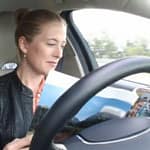Telecommunications and transportation used to be relatively disparate industries.From coordinating logistics to the purchase of tickets by passengers, telecommunications served more as a “signaling” function facilitating the flow of transportation, but not part of the transportation. Over time, however, communications capability has become an integral to many vehicles, such as “fly-by-wire” systems that use a local area communications network to replace heavier mechanical parts, improving efficiency and providing new opportunities.
An example of a potential new opportunity is seen in this video from Volvo, which features a test of a “Road Train”, which was done as part of the SARTRE (Safe Road Trains for the Environment) project. In this test, a convoy of five cars, driven in regular traffic, is assembled on the fly via a communications network (think Bluetooth pairing for cars). Relying on cameras and RADAR, each car is spaced approximately 20 feet apart at speeds over 50 miles per hour, while one driver literally leads the pack through an invisible communications tether.

Safety, improved efficiency (decreased drag for the virtual trailers, improves overall efficiency) and driver relaxation (check out the lady reading her magazine, while driving) are some of the benefits.
As pointed out in the video, the road train concept is still nascent and many issues beyond the basics of technology need resolution including:
- What is the business model? Who pays the driver and what is the impact, if any, of the increased costs of communications capabilities. Presumably the increase in safety would decrease costs to society and would be reflected in lower insurance premiums.
- What about the human aspect? How long will it take society to adjust to driverless cars?
- Laws and regulations need to be updated (see the State of Nevada for one that is already on the leading edge of this sort of legislation). Reliability, privacy and security will be critical in order to gain the trust of lawmakers, regulators and the public.
Still, the road train is an approach that could change the way society thinks about fixed transportation infrastructure, such as passenger rail projects. Instead of building a fixed rail that is point-to-point and used a couple of times a day, one could have a reconfigurable, multi-point to multi-point, packet-like transportation network that could be used all day long. Granted, one might not be able to obtain the same speeds, but the increase in efficiency, the ability to reach more places, plus retaining the freedom of an individual vehicle at the end destination is something worth a closer look.
One thing that is clear, with advances like the SARTE road train and the work Google (check out this humorous take on Google’s autonomous NASCAR race car) and others are doing with autonomous vehicles, reliable and secure communications will continue to increase in importance to the transportation industry.

Leave a Reply